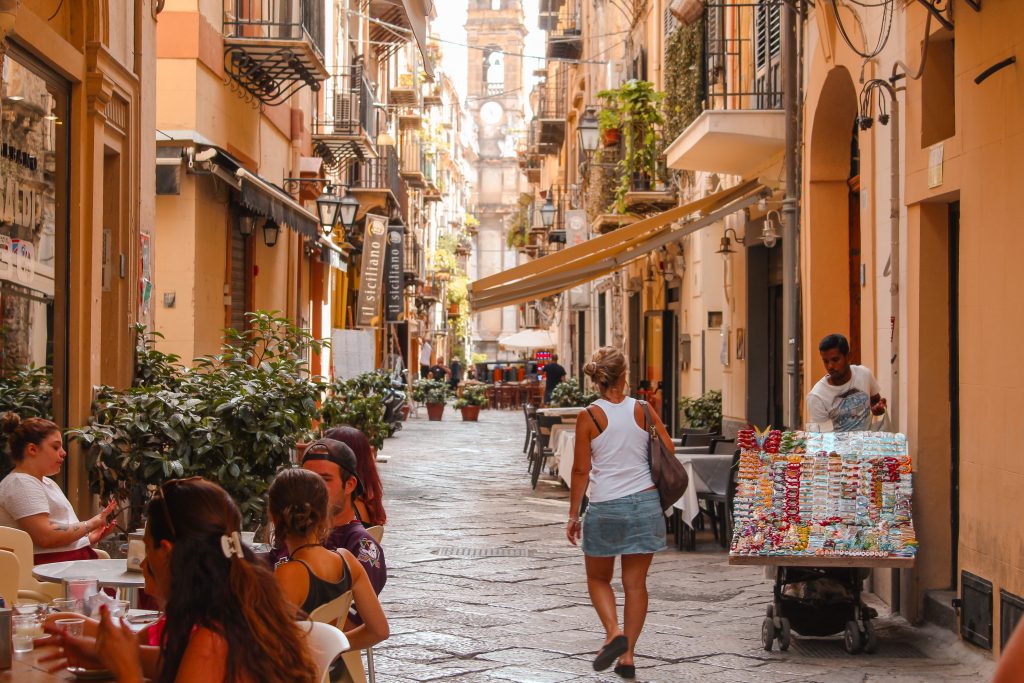5 Steps to Create a Travel Itinerary for Your Language Immersion Trip
We study a foreign language because we enjoy the priceless experience of visiting a foreign country and feeling at ease
Imagine traveling to Italy and feeling at home: shopping in Italian at the local market and preparing your lunch with the fresh vegetables you purchased in the morning. Imagine relaxing on your couch after dinner and watching a good Italian movie on TV, or walking your dog through the cobblestone streets of a medieval Italian town at dusk.
To be honest, feeling at home in a foreign country entails abandoning everything you have done as a tourist previously. As a non-Italian, it takes bravery to let yourself go and fully immerse yourself in the local culture.
You can have an experience like this in Italy by planning a Do It Yourself Italian Immersion trip. I’ll demonstrate how!
It’s time to break out of your shell, forget about the classroom and your Italian teacher, and unleash your inner Italian superpower (Also, reward yourself after years or months of hard work.)

Let’s get down to business…
1. How to Choose a City for Your Italian Immersion Trip
Do you prefer the beach or the Alps, or do you prefer the hustle and bustle of a bustling city? Whatever your tastes are, Italy has it all.
The general rule is to choose a location that is not overrun with tourists, and where locals will be curious about you and willing to speak with you. Remember that off-the-beaten-path destinations are surprisingly inexpensive and beautiful.
2. What Kind of Accommodation Should you Choose?
- Homestay at a teacher
- Airbnbs
- Bad&breakfasts
If you can live with a native Italian speaker, you will be in the best possible situation. If your budget allows it, home-stays with Italian teachers (which many Italian language schools arrange) are excellent ways to gain quick fluency.
Renting a room in an Airbnb flat is another excellent option. The owner will not be present the majority of the time, and she will not be your teacher. A guarantee of greater freedom and more natural interaction.
If you decide to stay in a homestay, make sure to check out Melissa’s blog (studentessa matta), which has number of recommended options in terms of trusted home-stay in different Italian locations.
3. Things you Can Do to Practice Your Italian
Explore Italy through the lens of a local
One of the best things to do when you arrive in a new city is to take a tour of the city with a local.
It will help you navigate the city during your stay and save you time on the first day trying to figure out what is the quickest way to the center or where the locals hang out. In Italy, you have the option of
- Uffici del turismo provide official guided tours (there is one in every city)
- Free tours: these are more informal tours that usually allow you to interact with the other participants.
- Private local guides
Hire a temporary Italian teacher
You can use the website Superprof (a less expensive option) or contact a local Italian language school (expensive option).
You can also use Airbnb’s experience section to find locals who offer Italian language learning experiences. You can also use our services and learn Italian with one of our teachers online during your Italian
The advantages of hiring an Italian teacher on the spot are numerous.
Even if you only meet him for an hour a day or less, he will most likely be the best source of interesting facts about the city you are visiting.
Take an Airbnb experience
What’s better than joining an experience led by locals, such as cooking classes at at a private home, painting classes, and yoga classes. This is an excellent way to improve your Italian while doing something useful.
Live as a local
Participate in the same activities that you would in your home country. Buying groceries at the local market, going to the movies, or even going to the gym can quickly become Italian immersive activities. Do you recall the last time you went to Italy as a tourist? Toss it aside.
Forget about sightseeing and fancy touristy restaurants.
Immerse yourself in local culture.

PROS of planning a DIY Italian immersion trip
- It will be less expensive than you think. Traveling as a tourist (eating at restaurants, purchasing tickets to attractions, shopping) is, in my opinion, far more expensive than experiencing a place as a local.
- Accommodations away from the tourist traps are significantly less expensive and are frequently run by a family.
- Prioritize slow living over tourist activities; instead, you will stay in the same place for a while and relax.
- Living like a local will provide you with a better understanding of the Italian way of life, as well as more natural interaction. All of this is provided for free.
DONT’S
I know it’s tempting, but
- Don’t plan your Italian language immersion trip in a popular tourist destination for two reasons: you will be tempted to behave like a tourist and miss out on authentic Italian immersion activities. The locals are used to to foreigners and will be uninterested in interacting with you or speaking Italian.
- Avoid traveling with non-Italian speaking friends.
- Do not schedule it for August – August is the worst month to visit Italy and expect to live like a local. The majority of the locals will be elsewhere. August is the most popular month for Italians to go on vacation.
- Do not enroll in an Italian language school. Although there are some excellent Italian language schools, classrooms frequently include students of various levels. You run the risk of having a perfect international experience rather than a local one.
Now, I’m sure you’re wondering, “What is a beautiful (but not overly touristy) medium-sized city that I can easily get to?” (by plane or train)…
Well, I’ve got an answer for you.
If I had to spend a week or two exploring an Italian city like a local, I would most likely go to…
Northern Italy
- Aosta, Mantova, Trieste, Modena, Ferrara
Central Italy
- Terni, Gaeta, Viterbo, Ancona
Southern Italy
- Salerno, Bari, Lecce, Cosenza, Monopoli
Sicily & Sardegna
- Siracusa, Trapani, Modica, Cagliari, Alghero







